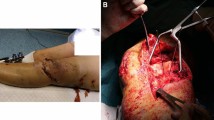Abstract
Unstable proximal femur fractures above a knee revision stem are an emerging complication that is especially difficult to treat. Since this pattern does not adapt to any previously reported classification, we named it “inverted Vancouver C fracture”. In this single-centre case series, we pose a nail–plate combination for the treatment of such clinical picture. The incidence was low among proximal and implant-related femoral fractures. All the fractures healed without records of major local complications. Thus, we consider this technique safe and reproducible.



Similar content being viewed by others
Change history
16 August 2021
A Correction to this paper has been published: https://doi.org/10.1007/s00590-021-03091-0
References
Meek RMD, Norwood T, Smith R, Brenkel IJ, Howie CR (2011) The risk of peri-prosthetic fracture after primary and revision total hip and knee replacement. J Bone Joint Surg Br 93B(1):96–101
Parvizi J, Jain N, Schmidt AH (2008) Periprosthetic knee fractures. J Orthop Trauma 22(9):663–671
Meinberg EG, Agel J, Roberts CS, Karam MD, Kellam JF (2018) Fracture and dislocation classification compendium-2018. J Orthop Trauma 32(Suppl 1):S1–S170
Rizkalla JM, Nimmons SJB, Jones AL (2019) Classifications in brief: the Russell-Taylor classification of subtrochanteric hip fracture. Clin Orthop 477(1):257–261
Seinsheimer F (1978) Subtrochanteric fractures of the femur. J Bone Joint Surg Am 60(3):300–306
Mayhew D, Mendonca V, Murthy BVS (2019) A review of ASA physical status—historical perspectives and modern developments. Anaesthesia 74(3):373–379
McPherson EJ, Woodson C, Holtom P, Roidis N, Shufelt C, Patzakis M (2002) Periprosthetic total hip infection: outcomes using a staging system. Clin Orthop 403:8–15
Rhee SJ, Cho JY, Choi YY, Sawaguchi T, Suh JT (2018) Femoral periprosthetic fractures after total knee arthroplasty: new surgically oriented classification with a review of current treatments. Knee Surg Relat Res 30(4):284–292
Masri BA, Meek RMD, Duncan CP (2004) Periprosthetic fractures evaluation and treatment. Clin Orthop 420:80–95
Xu BY, Yan S, Low LL, Vasanwala FF, Low SG (2019) Predictors of poor functional outcomes and mortality in patients with hip fracture: a systematic review. BMC Musculoskelet Disord 20(1):568
Warren J, Sundaram K, Anis H, McLaughlin J, Patterson B, Higuera CA et al (2019) The association between weight-bearing status and early complications in hip fractures. Eur J Orthop Surg Traumatol Orthop Traumato 29(7):1419–1427
Ottesen TD, McLynn RP, Galivanche AR, Bagi PS, Zogg CK, Rubin LE et al (2018) Increased complications in geriatric patients with a fracture of the hip whose postoperative weight-bearing is restricted: an analysis of 4918 patients. Bone Jt J 100-B(10):1377–1384
Haidukewych GJ, Israel TA, Berry DJ (2001) Reverse obliquity fractures of the intertrochanteric region of the femur. J Bone Joint Surg Am 83(5):643–650
Willoughby R (2005) Dynamic hip screw in the management of reverse obliquity intertrochanteric neck of femur fractures. Injury 36(1):105–109
Streubel PN, Moustoukas MJ, Obremskey WT (2013) Mechanical failure after locking plate fixation of unstable intertrochanteric femur fractures. J Orthop Trauma 27(1):22–28
Warwick DJ, Crichlow TP, Langkamer VG, Jackson M (1995) The dynamic condylar screw in the management of subtrochanteric fractures of the femur. Injury 26(4):241–244
Sadowski C, Lübbeke A, Saudan M, Riand N, Stern R, Hoffmeyer P (2002) Treatment of reverse oblique and transverse intertrochanteric fractures with use of an intramedullary nail or a 95 degrees screw-plate: a prospective, randomized study. J Bone Joint Surg Am 84(3):372–381
Kulkarni SS, Moran CG (2003) Results of dynamic condylar screw for subtrochanteric fractures. Injury 34(2):117–122
Lehmann W, Rupprecht M, Nuechtern J, Melzner D, Sellenschloh K, Kolb J et al (2012) What is the risk of stress risers for interprosthetic fractures of the femur? A biomechanical analysis Int Orthop 36(12):2441–2446
Valle Cruz JA, Urda AL, Serrano L, Rodriguez-Gonzalez FA, Otero J, Moro E et al (2016) Incidence of and risk factors for femoral fractures in the gap between hip and knee implants. Int Orthop 40(8):1697–1702
Campillo-Recio D, Videla-Ces M, Sales-Pérez M, Molina-Olivella G, Videla S (2019) Inter-implant fractures: an unmet medical need-a preventive approach proposal. Eur J Orthop Surg Traumatol Orthop Traumatol. https://doi.org/10.1007/s00590-019-02581-6
Stoffel K, Sommer C, Kalampoki V, Blumenthal A, Joeris A (2016) The influence of the operation technique and implant used in the treatment of periprosthetic hip and interprosthetic femur fractures: a systematic literature review of 1571 cases. Arch Orthop Trauma Surg 136(4):553–561
Ciaffa V, Vicenti G, Mori CM, Panella A, Conserva V, Corina G et al (2018) Unlocked versus dynamic and static distal locked femoral nails in stable and unstable intertrochanteric fractures. A prospective study. Injury 49(Suppl 3):S19–S25
Skála-Rosenbaum J, Džupa V, Bartoška R, Douša P, Waldauf P, Krbec M (2016) Distal locking in short hip nails: cause or prevention of peri-implant fractures? Injury 47(4):887–892
Nakano S, Yoshioka S, Tezuka F, Nakamura M, Chikawa T, Shimakawa T (2013) New surgical treatment using a docking nail for postoperative periprosthetic femoral fracture after total hip arthroplasty. J Arthroplasty 28(2):326–330.
Funding
This study had no funding.
Author information
Authors and Affiliations
Corresponding author
Ethics declarations
Conflict of interest
The authors declare that they have no conflict of interest.
Additional information
Publisher's Note
Springer Nature remains neutral with regard to jurisdictional claims in published maps and institutional affiliations.
Rights and permissions
About this article
Cite this article
Peiró, J.V.A., Ruiz, M.J., Hernández, J.T. et al. The inverted Vancouver C fracture. Case series of unstable proximal femur fractures above a knee revision stem treated by short cephalomedullary nail and lateral submuscular overlapping plate. Eur J Orthop Surg Traumatol 31, 193–198 (2021). https://doi.org/10.1007/s00590-020-02738-8
Received:
Accepted:
Published:
Issue Date:
DOI: https://doi.org/10.1007/s00590-020-02738-8




